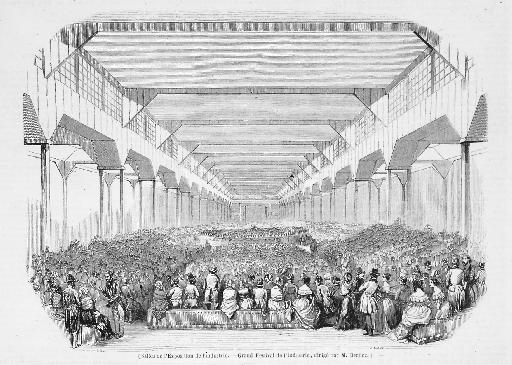(Hector Berlioz,1844)
 Euphonia is a small town of twelve thousand souls, situated on the slopes of the Hartz, in Germany. The whole town may be looked upon as a great conservatory of music, since the exercise of this art is the sole purpose of its inhabitants’ labors….
Euphonia is a small town of twelve thousand souls, situated on the slopes of the Hartz, in Germany. The whole town may be looked upon as a great conservatory of music, since the exercise of this art is the sole purpose of its inhabitants’ labors….
The signal for working hours, meals, and meetings by streets and wards, as well as for rehearsals in small or large groups, is given by a huge organ situated at the top of a tower rising above all the buildings of the town. This organ is worked by steam, and so powerful that its tones can easily be heard ten miles away. Five centuries ago, when the ingenious manufacturer Adolphe Sax, to whom we owe the invaluable group of brass reed instruments bearing his name, put forward his idea of a similar organ designed to perform in more musical fashion the function of bells, he was looked upon as a lunatic – just like the unfortunate man who still earlier had talked of applying steam power to navigation and railways, or like those who two centuries ago steadfastly worked at the means of steering aerial flight, which has changed the face of the world.
The language of the tower organ, this aural telegraphy, is hardly understood by any but Euphonians; they alone are familiar with telephony, an invention whose importance was foreseen by one Sudre in the nineteenth century, and which one of the prefects of harmony in Euphonia developed and brought to the degree of perfection it has reached today. The Euphonians also communicate by visual telegraphy, and the rehearsals leaders have only to make a simple gesture with either or both hands and the conductor’s baton, to indicate to the performers that they are to give out, loud or soft, such and such a chord followed by such and such a cadence or modulation; or to perform a given classical work either all together or in a small body, or again in crescendo, by having the divers groups enter in succession….
The grand ensemble next undergoes the composer’s criticism. He listens from the upper part of the amphitheater, which the public will occupy; and when he finds himself the absolute master of this huge intelligent instrument, when he is sure that nothing remains but to communicate to it the vital nuances that he feels and can impart better than anyone else, the moment has come for him to become a performer himself. He climbs the podium to conduct. A tuning-fork attached to every desk enables the instrumentalists to tune noiselessly before and during the performance; trial runs or any other noises, however slight, are absolutely forbidden. An ingenious mechanism, which might have been invented five or six centuries earlier if someone had taken the trouble to design it, and which is actuated by the conductor without being visible to the public, indicates to the eye of each performer, and quite close to him, the beats of each measure. It also denotes precisely the several degrees of piano or forte. In this way the performers are immediately and instantly in touch with the conductor’s intention, and can respond to it as promptly as do the hammers of a piano under the hand pressing the keys. The maestro can then say in all truth that he is playing the orchestra.


